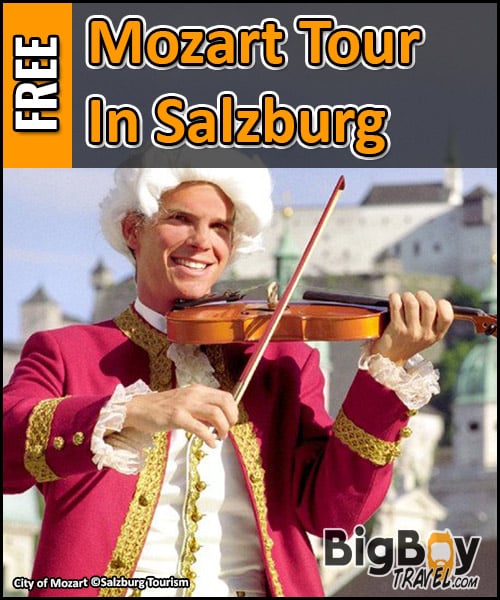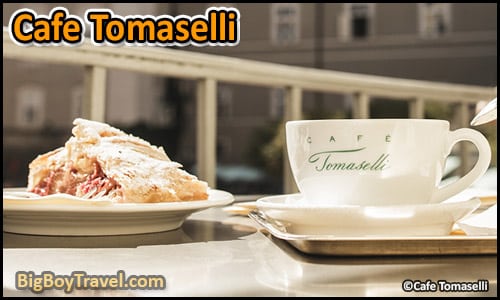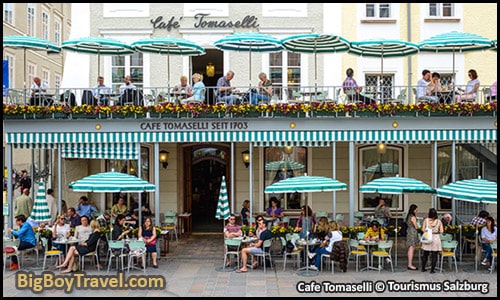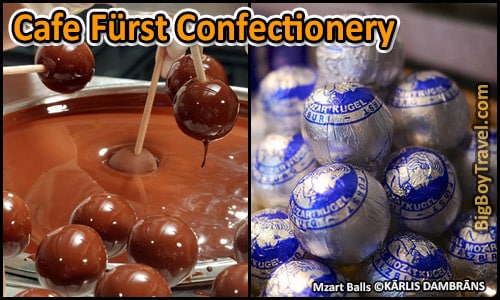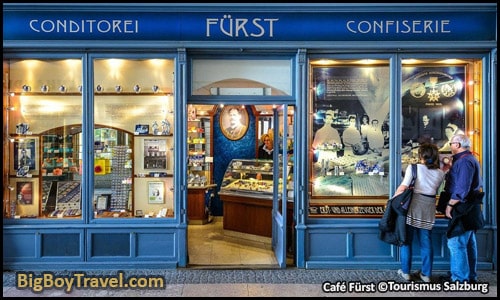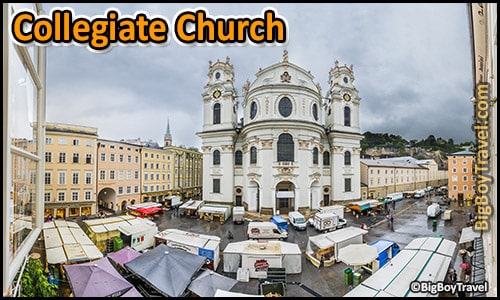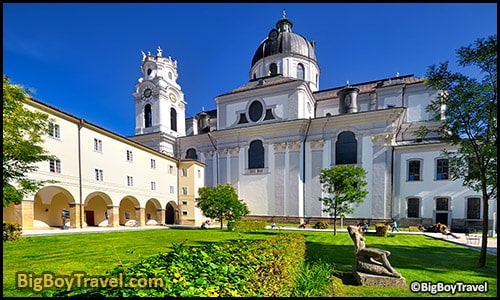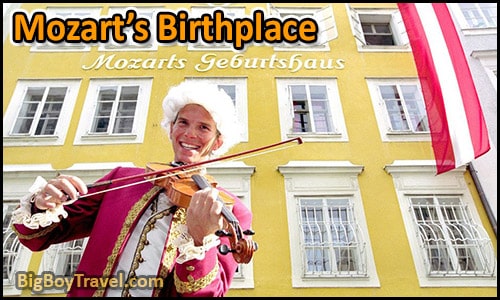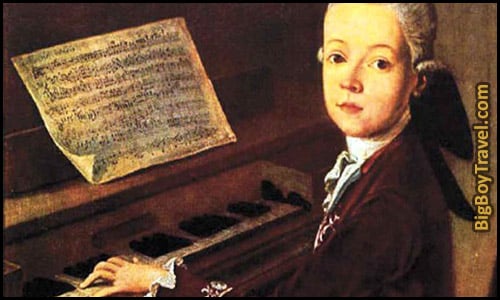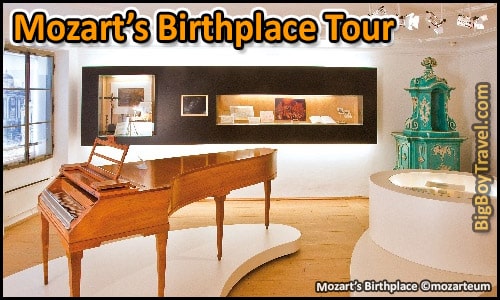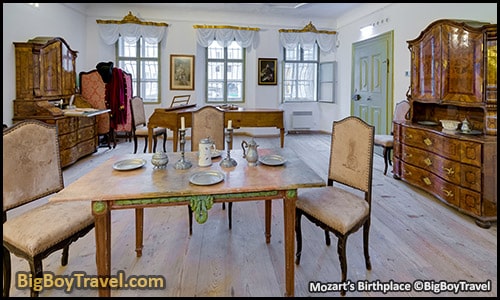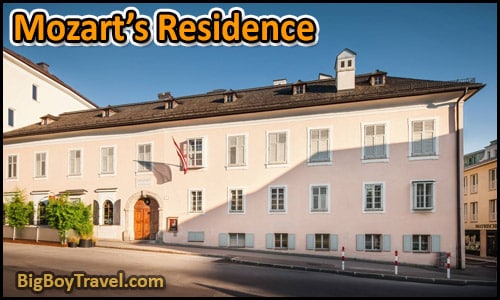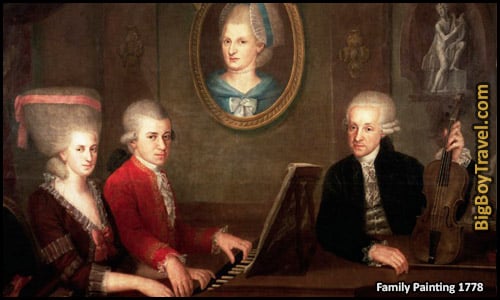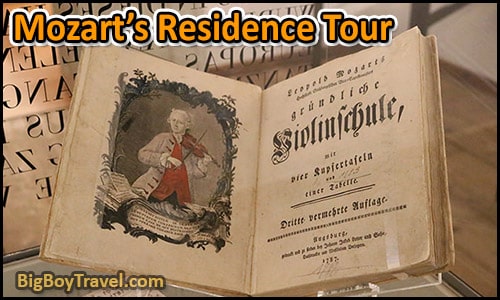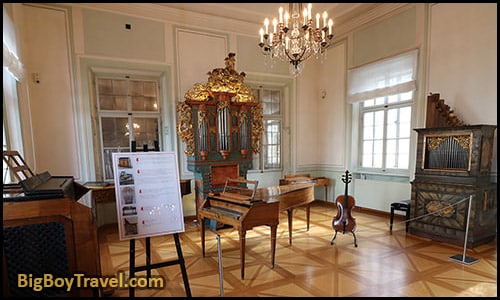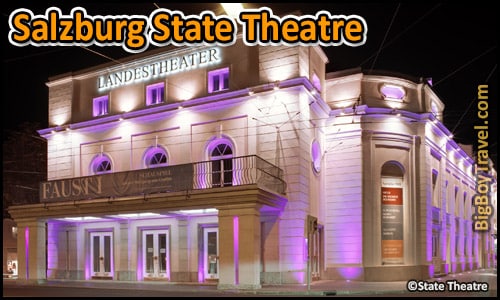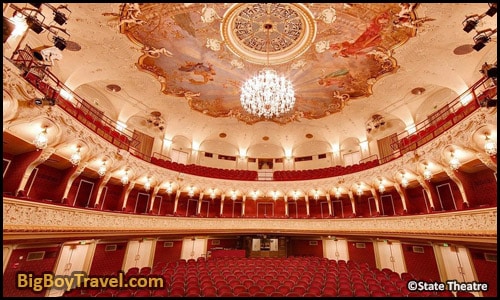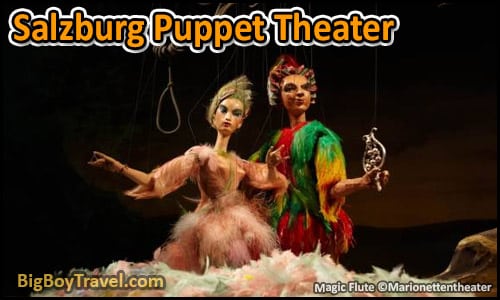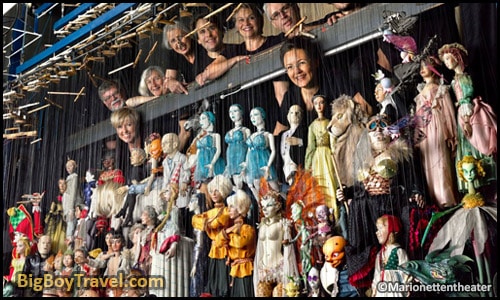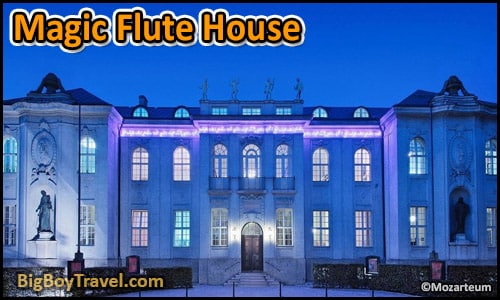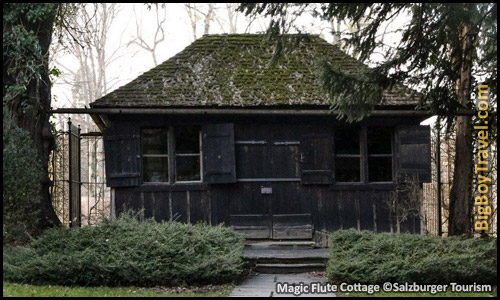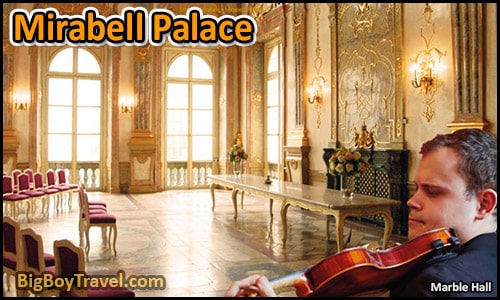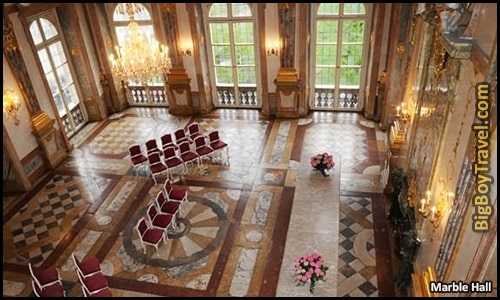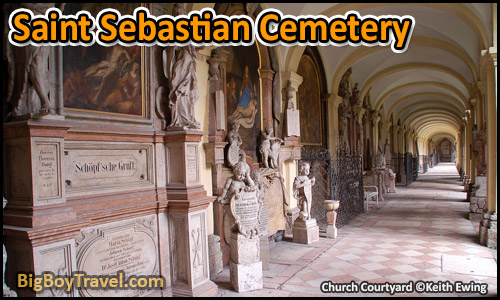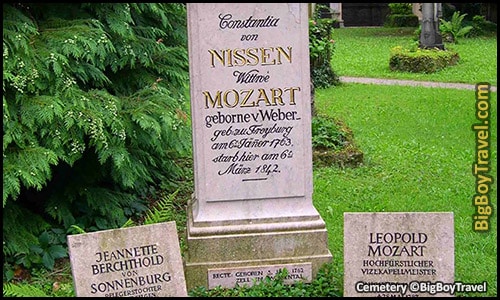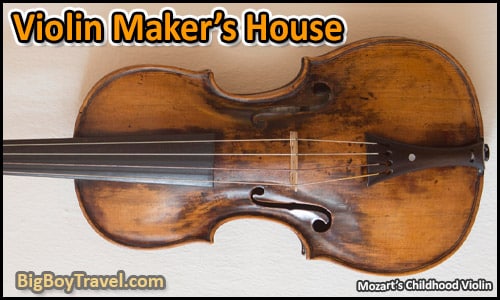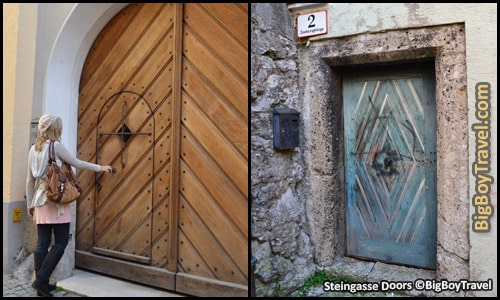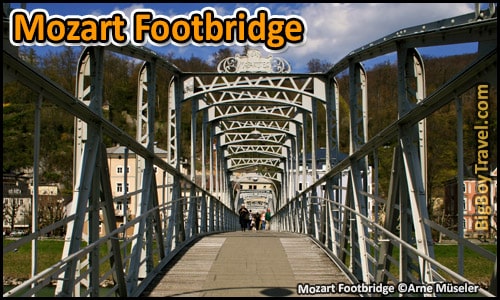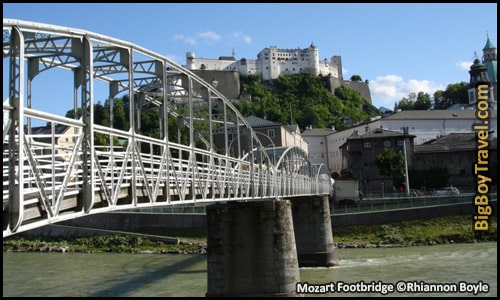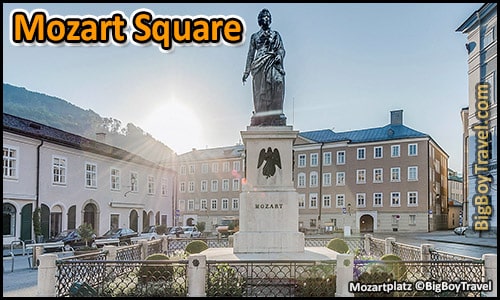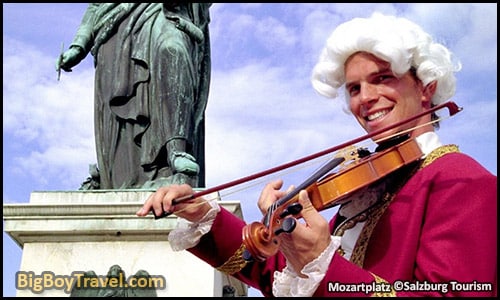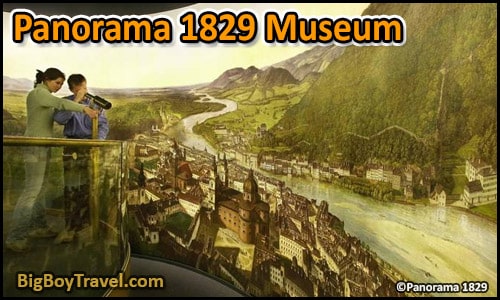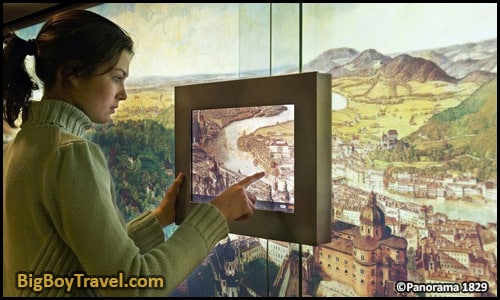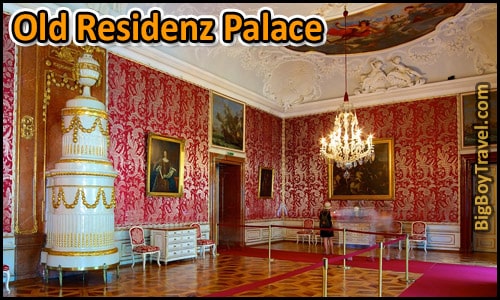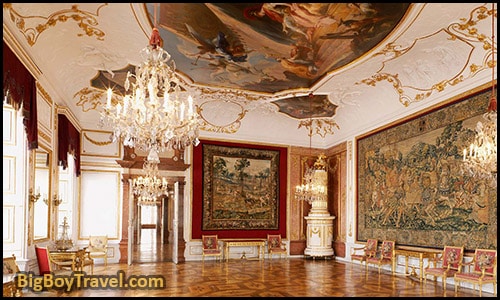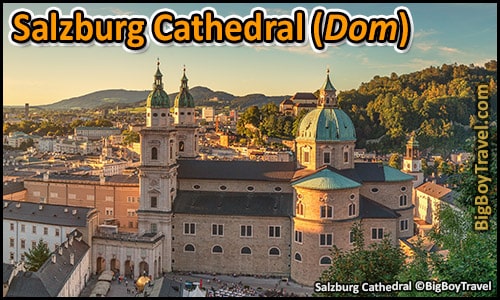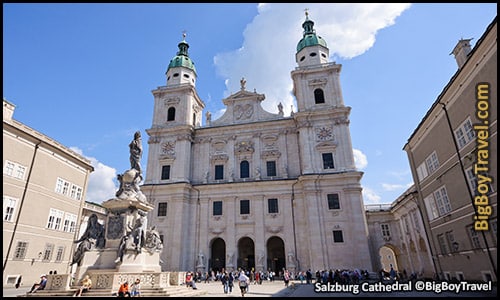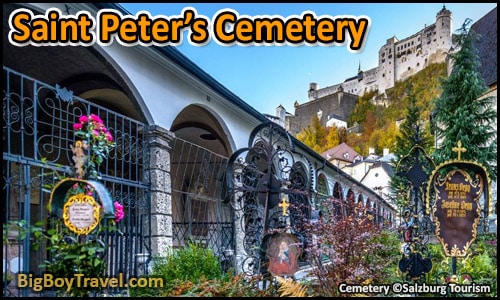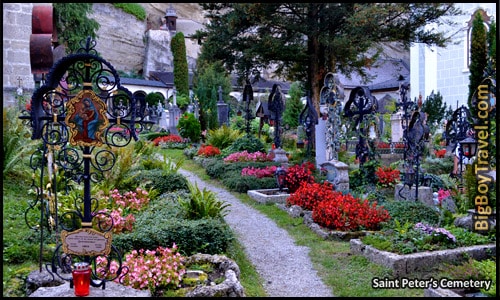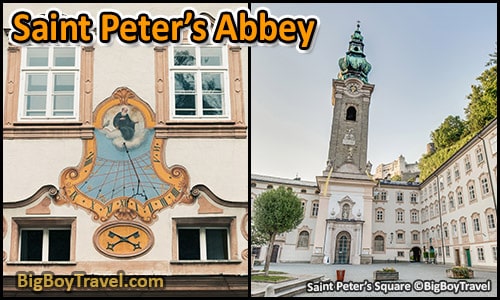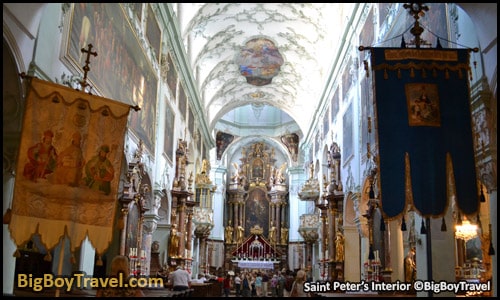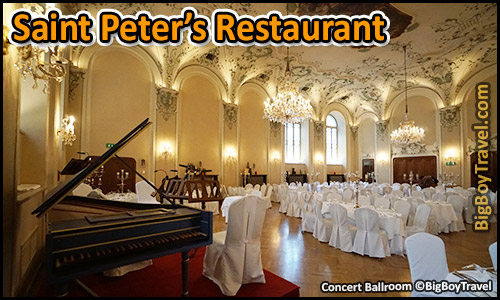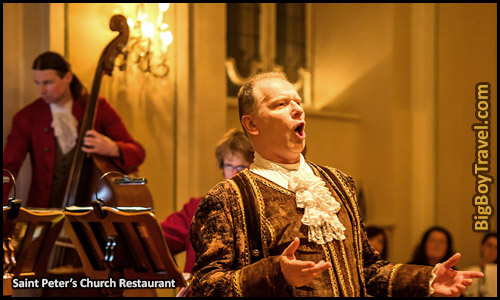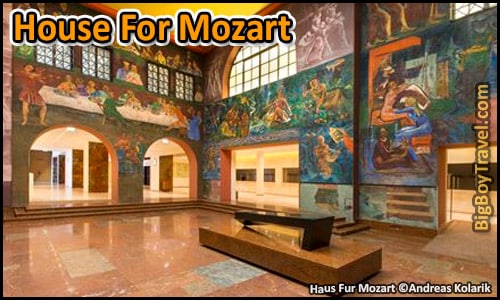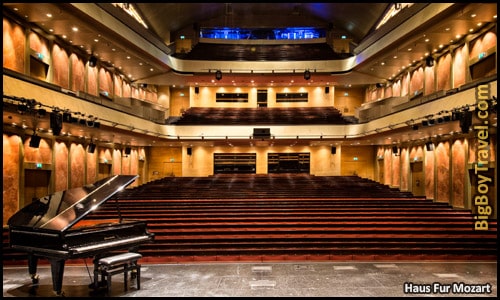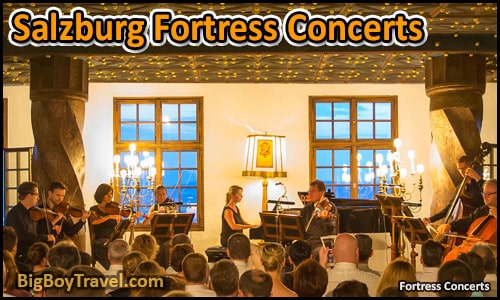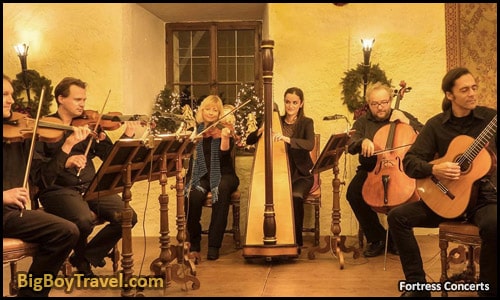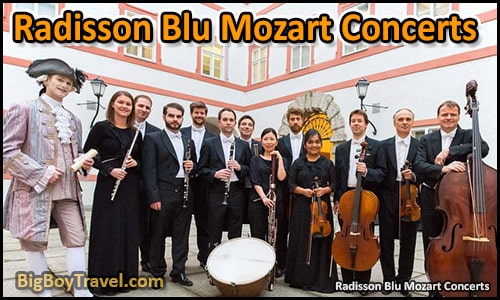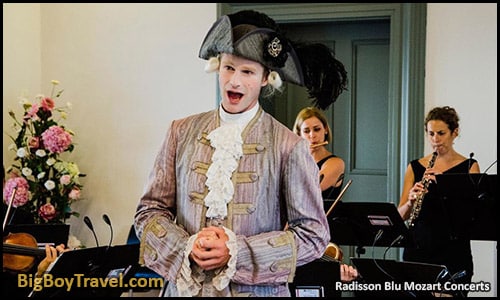Free Mozart Walking Tour:
Walking Tour Location: Salzburg City Center (Altstadt)
Cost: Free, Self-Guided (Mozart Museum costs listed below)
Style: Do-It-Yourself Walking Tour (Self Guided)
Start: Café Tomaselli
End: Saint Peter’s Restaurant (Stiftskulinarium)
Walking Distance: 2.1 Miles (+0.5 inside Museums)
Time: 90 Minutes For Walk (with attractions 4-5 hours)
Fun Scale: 9.5 out of 10
Mozart Tour Overview:
While many Americans travel to Salzburg chasing the allure of The Sound of Music, the real pride of the city is its favorite son, Wolfgang Amadeus Mozart. Born in Salzburg on January 27th, 1756, Mozart would grow from a young child prodigy into someone who revolutionized classical music and culture worldwide even though he only lived until the age of 35. Mozart lived in Salzburg with his family for the first 25 years of his life setting the groundwork for the hills to truly be alive with the sound of music.
On our free Mozart walking tour in Salzburg will take you through some of the most important locations of the famous composer’s life. You’ll visit his birthplace, see his family’s second home in Salzburg, go to one of Mozart’s favorite cafes, stroll the streets he grew up, and many learn about famous locations associated with his music. Following this self-guided Mozart tour is a real treat for all levels of his fans from the casual to the hardcore, enjoy!
Eight Interesting Mozart Facts:
1. His Real Name: While you may know him as Wolfgang Amadeus Mozart, his real birth name was Johannes Chrysostomus Wolfgangus Theophilus Mozart.
2. Infant Mortality: While Mozart was one of 7 children, he and his sister Maria Anna (nicknamed Nannerl) were the only 2 to live past infancy which was very common in the 1700s. Wolfgang himself had 6 children with his wife, but only 2 of them lived past infancy.
3. Famous Sister: While Wolfgang became the most famous Mozart, his sister Nannerl (4.5 years his elder) was the family’s first child prodigy. By age 12 she was one of the most skillful musicians in Europe but had to give up music when she turned 18 as she had become “marriage aged”.
4. Grand Tour: Out of his 35 year life, Mozart spent 10 years, 2 months and 2 days (3720 total) traveling by horse carriage around Europe. One tour with his sister took over 3 years (1773-1776) and covered performances in 88 cities. Travel was very was slow and uncomfortable with just Vienna (now a 2.5 hour train) taking a week.
5. Super Composer: In addition to being a talented musician, Wolfgang wrote his first piece at age 6 (Minuet and Trio in G major), his first symphony by age 8, his first opera by age 11 (Apollo et Hyacinthus), and produced a more than 626 works before his death at age 35.
6. Memory Power: While visiting the Rome in 1773, Mozart heard Gregorio Allegri’s Miserere performed in the Vatican’s Sistine Chapel was able to write out the entire score from memory.
7. Married For Love: While Pope Clement XIV had bestowed an honorary royal title on Mozart for his religious songs, he chose not to marry a baroness and instead went “below his station” to marry for love against his dad’s wishes.
8. Death Mystery: No one knows for sure how Mozart died (suspected kidney failure or poisoning) or where he is buried although he has a tomb for show in Vienna. Because he had substantial debts, Wolfgang was buried in a common man’s grave with little fanfare which was later dug up for other burials.
Mozart Walking Tour Sights:
1. Café Tomaselli:
About Café Tomaselli: It’s said that the Turks left behind bags of coffee beans during the failed Siege of Vienna in 1683 which quickly led to a thriving coffee culture through Austria. Frenchmen Johann Fontaine opened the first cafe in Salzburg on nearby Goldgasse in the year 1703, which was moved to the present location in 1764 and acquired by Carl Tomaselli in 1852. This makes the historic Café Tomaselli in the heart of Medieval Salzburg’s main marketplace, Old Market (Alter Markt), the oldest cafe in Austria.
In addition to the age of the coffee shop, Wolfgang Amadeus Mozart was a frequent guest of Café Tomaselli where his beverage of choice was almond milk. For coffee lovers, the iconic drink in Austria is a strong, black coffee typically served in a high glass with a dash of whipped cream called an Einspänner. We love to get our coffee an drink it on the second-floor balcony overlooking the square. Mozart’s widow Konstanze even lived upstairs from the cafe with her second husband from 1824-26 until his death. It was here where they worked on Mozart’s biography today which she published in 1828.
As you drink your coffee where Mozart once drank his almond milk, make sure to admire the Old Market Square. In Roman times the city was called Luvaum (controlled from 15BC-488AD) and this square was where the only bridge over the Salzach River entered the heart of town from 15AD until 1859AD. Salzburg gained grain market rights in 996AD (when Austria was formed) and then grew its Old Market Square starting in 1297AD after the city was granted political sovereignty from Bavaria. We love the square’s Saint Florian Fountain which goes back to 1488 and has a statue of the Saint added in the 1700s. Café Tomaselli is the best place to start our free Mozart walking tour in Salzburg as you get to retrace the composers own steps.
Hours: Monday-Saturday 7am-9pm; Sunday 8am-9pm. Address: Alter Markt #7. Website: Here.
Mozart Connection: Was the Cafe Wolfgang frequented the most in Salzburg and his beverage of choice was their almond milk. Mozart’s widow Konstanze lived upstairs from 1824-26 where she worked on his biography.
2. Cafe Fürst Confectionery (Konditorei):
About Café Konditorei Fürst: Sitting just across the Old Market Square from Café Tomaselli, Café Konditorei Fürst where confectioner Paul Furst created the world-famous Mozart Chocolate Balls (Mozartkugel) in 1890. An authentic Mozartkugel is covering in chocolate with a marzipan center with pistachio, the finest nougat, and must be perfectly round. To this day, the delicious treats are still made expertly by hand following the original recipe. It is not to be overlooked that the cafe also has delicious coffee and a wide range of other sweet treats available.
Since the creation of the popular Mozartkugel, there have been many imitators as Paul Furst never applied for a patent to protect. We highly suggest going with the authentic Furst Mozart Chocolate Balls and buying a couple extra sweets to bring with on our free Mozart walking tour in Salzburg. The original Mozartkugel are still wrapped in silver foil with a blue Mozart portrait. You can notice that on the logo for the Furst Mozartkugel they flattened Mozart’s nose to give him a more youthful appearance even though in real life he had a bit of a hump on his nose. The most popular competitor you will see around town is in a red and yellow foil wrapper made by the Mirabell company. Its portrait of Mozart is also interesting as it has him depicted with the brown eyes he had in real life even though in many paintings at the time they were changed to blue.
Hours: Monday-Saturday 8am-8pm; Sunday 9am-8pm. Address: Alter Markt #13. Website: Here.
Mozart Connection: Makers of the Original Mozartkugel chocolate ball candies in a silver foil wrapper, although other companies have tried to copy them.
3. Collegiate Church (Kollegienkirche):
About Collegiate Church: The massive white church towering over University Square (Universitätsplatz) has a boring interior but it holds a special place on this free Mozart walking tour in Salzburg. It was in this cathedral where Mozart premiered “Mass in D minor” on February 5th, 1769 and it is one of his prettiest songs. This arrangement may be the most beautiful song Mozart wrote during the years he lived in Salzburg and he was only 13 years old.
The construction of Collegiate Church was started in 1694, but took over 70 years to fully complete as the original builder went blind a few years into the project. Hidden along the West side of the church is the wonderful Prince′s Park (Furtwänglerpark) which was once part of a Franciscan Monastery and became part of the University of Salzburg by the 1600s. It was in the Great Hall (Aula Theater) of the University where Mozart first publicly performed at age of 5. The performance was a dance in his school’s Latin play Sigismundus Hungariae Rex. He later premiered his first true opera (Apollo et Hyacinthus) here in Latin on May 13th, 1767 at age 11.
Salzburg’s main open-air market sits in the vast University Square on the North side of the church with growers from all over the region selling delicious produce. Known as the Green Market (Grünmarkt), it was established in 1857 and is still open daily. We recommend recharging here by buying some fruit and taking a short break to do some people watching. One of the best views of the market is looking down from the windows on the backside of Mozart’s Birth Place House (Universitätspl #14) which we will tour next on this free Mozart walking tour.
Outdoor Market Hours: Monday-Friday 7am-7pm; Saturday 6am-3pm; Sunday Closed. Church Website: Here.
Mozart Connection: This church is where Wolfgang premiered “Mass in D minor” at age 13 and the Grand Hall inside the neighboring Salzburg University is where he publicly performed for the first time at age 5 in dance for a school play and later premiered his first true opera at age 11.
4a. Mozart’s Birthhouse History (Geburtshaus):
About Mozart’s Birthhouse: If you only have time to visit one site on this free Mozart walking tour in Salzburg, make sure it is this historic house where Wolfgang Amadeus Mozart was born on January 27th, 1756 and lived until he was 17. You simply can’t miss the home located right in the heart of Salzburg with its bright yellow facade and large groups of tourists milling around the entrance. This museum is by far the most visited Mozart landmark in Salzburg and we especially love the Medieval elements like the pull-chain doorbell near the door.
In 1747, the family patriarch Leopold Mozart rented a 3-room apartment on the third floor with his wife which was owned by local tradesman and delicatessen owner Johann Lorenz Hagenauer. Leopold was a chamber musician and renown music teacher who had recently been appointed to the work in the Prince-Archbishop’s Court in Salzburg. Their apartment consisted of a small study room, living room, and bedroom where Mozart was born. All seven of the couple’s children were born here, although only two survived: Maria Anna Walburga (known as Nannerl) in 1751 and Joannes Chrysostomus Wolfgangus Theophilus (Wolfgang Amadeus) in 1756. Yes, you read that correctly, his official name isn’t what you thought it was.
Known today as the Mozart Birthhouse (Geburtshaus), this is also where Leopold wrote his small yellow book entitled Notenbuch für Wolfgang the same year Wolfgang was born which is now on its 1800th edition. It was around 1759 that Leopold realized the children were musically gifted when he found out that 7-year-old Nannerl was excellent harpsichord player and fortepianist. Just a toddler at the time, Mozart idolized his older talented sister and just 3 years later they were already performing together. The children played for noble audiences and numerous events including a private show for Elector Maximilian III in Munich and Empress Maria Theresa in Vienna.
The family’s Grand Tour of Europe from 1763-66 is their most famous which saw them perform as far away as London. Because family developed a close relationship with the Hagenauer, who owned the Mozart Birthhouse, their letter correspondence is how we know a lot about Wolfgang’s childhood and the Grand Tour. In total, they visited 88 cities over serval thousand miles of travel in just over 3 years. While on the road in 1764 Mozart is said to have composed his first symphony in London at only 8 years old.
During the Grand Tour, Leopold said of the rising star Nannerl, “Although she is only 12 years old, is one of the most skillful players in Europe.” Unfortunately, by 1769 the young child prodigy Nannerl was forced to give up performing music when she turned 18 as the culture of the day considered her marriage age. We will never know how good Nannerl could have been as on her brother’s future tours she had to stay behind at the Mozart Birthhouse, but continued to help Wolfgang with composition and dictation.
By 1773 the family upgraded to a new home in Salzburg which we will tour next, but thanks to the International Mozarteum Foundation the Mozart Birthhouse opened as a museum in 1880 to keep the history alive. Talking the self-guided tour of Mozart’s Birth Place is excellent and we explain it in detail below.
Mozart Connection: The house where Wolfgang was born on January 27th, 1756 and lived until he was 17 with his parents and talented sister Nannerl. Their father Leopold Mozart also wrote a famous music instruction book while living here.
4b. Mozart’s Birth Place Tour (Geburtshaus):
About The Mozart’s Birth Place Tour: A self-guided tour of the Mozart Birthhouse (Geburtshaus) covers three stories of interesting exhibits labeled in multiple languages and takes about 90 minutes to get through. There are helpful multi-lingual audio guides, interactive displays, and everything is labeled in both German and English.
Your tour starts on the 3-room 3rd floor (4th level) apartment where you are introduced to the stories and portraits of the individual family members and even get to check out the room where Mozart was born in. We also love the preserved Medieval kitchen, Mozart’s childhood violin (Kindergeige), and their full-sized piano as we learn about their personal history. There are also excellent views out of the Southern windows of the Mozart Birthhouse onto University Square (Universitätsplatz) which holds the Green Market (Grünmarkt) and massive Collegiate Church (Kollegienkirche) from earlier on this free Mozart walking tour. Remember that in Europe the ground level is counted as a floor so it’s 4 flights of stairs up to the 3rd floor and it’s not wheelchair or stroller friendly.
The 2nd floor primarily focuses on Mozart as a composer of operas. There are a lot of historic and contemporary set models, costumes from his operas, plus excerpts from Mozart’s most famous operas for you to listen to. We especially love the different musical instruments that are on display including their Clavichord wall piano. This quite piano was used to compose many famous works including Requiem. Many of his most famous operas were written later in life while he lived in Vienna, but the dreaming, writing, and designing started in Salzburg.
The 1st floor of the Mozart Birthhouse is dedicated to the everyday life of the family both while in Salzburg and while traveling. In addition to maps of the family’s famous Grand Tour of Europe, there are exhibitions on how it was to travel by horse carriage in the 1700s. There are collections of 18th-century travel utensils, original documents, and paintings telling the Mozart family’s story in Salzburg and abroad. In total Mozart spent 10 years, 2 months and 2 days (3720 total) of his 35-year life traveling by horse carriage with was slow and uncomfortable. Just going to Vienna from Salzburg at the time took nearly a week.
Also on the first floor are a series of interactive rooms where you get to listen to Mozart’s music in a whole new way. There are computer listening stations where you get to see the songs come alive on digital music sheets plus an amazing sensory room acoustically built to experience Mozart’s work. The tour rounds out with a few of the rooms are staged with period furniture to help give you the atmosphere of the age while they were at home. The family’s later years are covered more in-depth at the Residence Museum located next on this free Mozart walking tour.
Hours: Daily 9am-5:30pm; in July & August open 8:30am-7pm; last entry 30 minutes before closing. Cost: 11€ for Adults; 3.50€ for kids; 23€ for a family ticket. Combo ticket available with his adult home. Guided Tours: While the Museum is mainly self-guided and takes 90 minutes, you can book a staff-guided tour as well for 66€ per group. All staff tours must be booked at least 2 weeks in advance. Website: Here.
5a. Mozart’s Residence History (Wohnhaus):
About The Mozart’s Residence History: Welcome to the Mozart Residence (Wohnhaus) where Wolfgang Amadeus Mozart lived in with his family from age 17 to 25 (1773-1781). After the Leopold and Wolfgang returned from the road in 1773, the family used their position to substantially upgrade their housing. Located on Hannibalplatz (Makartplatz No. 8-9) they moved into an 8 room apartment on the 1st floor (second level) of the Dance Master’s House (Tanzmeisterhaus). This was considered extremely spacious for a family of four (and their servants) at the time as Old Town across the river where they were before had 15,000 residents crammed into just 700 houses.
The Dance Master’s House (Tanzmeisterhaus) was constructed as a duplex in 1617 and combined when Franz Gottlieb Spöckner was given permission to hold dance lessons for nobles in one half while living in the other. Spöckner was a friend of the Mozart family having served as a witness in Leopold and Anna’s wedding at the Salzburg Cathedral in 1747. After returning from the road in 1773 they rented half of Spöckner’s former home from his cousin who had been managing it since his death in 1765.
With the increased space, the Mozarts were any to have more room to rehearse music, teach music lessons, host social gatherings, and playing dart target shooting (Bölzlschiessen). The game was popular among young aristocrats and included 6-10 players shooting darts from airguns at humorously designed paper targets. Joining them in the home were their servants, pet songbirds, and a fox terrier dog named Pimperl. As royal court musicians, the children also gained access to the neighboring Mirabell Gardens which weren’t open to the public until 1854.
While Wolfgang lived here almost continuously until September 1777 he and his father frustrated by the lack of opportunity and income potential being under the thumb of their boss the Arch-Bishop of Salzburg. Mozart wrote around 12 mildly-acclaimed pieces a year here, but great a strong desire to write operas. Although there wasn’t much operatic work in Salzburg, his appetite grew watching people in the square near the Mozart Residence flock to the theater between 4-5 o’clock.
Being granted the right to seek other employment, Wolfgang traveled to Paris in 1778 where turned down a large salary of 450 florins a year and his mother Anna who was accompanying him died of illness on the trip. Mozart wrote is famed Sinfonia Concertante after his mom’s death (buried in Paris), but stayed living in Vienna where he started to freelance instead of returning to the family home.
Wolfgang left home permanently in 1781 and until 1784, Leopold lived at the Mozart Residence (Wohnhaus) with just Nannerl (now in her early thirties) and their servants. Early on Wolfgang tried to get permission to marry Constanze Weber in Vienna, but Leopold initially objected. This was mainly because Mozart had received a noble title of “Knight of the Golden Spur” from the Pope was accepted to marry a baroness, but ultimately was allowed to go below his status and married for love. Wolfgang had originally fallen Constanze’s sister Aloysia while the families toured doing music and blocked from pursuing her before later being allowed to court Constanze.
Leopold had also blocked Nannerl from getting permission to marry a man before finally marrying the City Administrator of the small rural town of Saint Gilgen at the age of 33. Although Saint Gilgen was where her mother was born, it was hours away by horse carriage (29 minutes by car), her previously twice married husband already had 5 ill-educated kids, and it left Leopold alone. In July 1785, Nannerl returned to the Mozart Residence in Salzburg to give birth to her first child, a son named Leo. This was the same year Wolfgang peaked in famed so even back Salzburg the family had plenty of money. While Nannerl soon returned to care for her stepchildren in Saint Gilgen, her infant son was raised in Salzburg by his grandfather (with servants) until Leopold’s death in May 1787.
After Leopold’s death, the family home changed hands many times, with all the owners treasuring the legacy. Two years after the Mirabell Gardens were made public in 1854 a large Mozart Wohnhaus to commemorate the property. The Stiftung Mozarteum tried to buy the home in the 1930s but it didn’t go through before Austria was annexed into Germany. During WW2, the Mozart Residence (Wohnhaus) was directly hit by air raid bombings on October 16th, 1944 which leveled 2/3rds of the building. In 1955 a more modern building replaced the part that was destroyed, but over 5 years from 1991 it was restored to its original state thanks to the Dai-ichi Life Insurance Company. The Mozart Residence opened as a full museum for treasures held at the Mozarteum on the 240th anniversary of Wolfgang’s birth on January 27th, 1996.
Mozart Connection: The house where Wolfgang lived with his family from age 17 until he moved to Vienna at 25. Their 8 room apartment was where the family held many social gatherings. The former owner of the home, and Court Dance Master, Gottlieb Spöckner was a witness for the wedding of Wolfgang’s parents in 1747.
5b. Mozart’s Residence Tour (Wohnhaus):
About The Mozart’s Residence Tour: Touring the home that Mozart lived in with his family from 1773-1781 is a real delight. Not only are there fewer tourists, but there are also many fewer steps which makes a tour of the Mozart Residence (Wohnhaus) a great companion to visiting his birth house. The exhibits here cover his later years in Salzburg from ages 17-25 more aspects of the family’s everyday life before Mozart moved to Vienna.
Starting on the 1st floor (2nd level) you get a great introductory lesson on the history of the Wohnhaus building with original documents and portraits. There are multiple original instruments of Mozart’s on display from his Italian Costa-violin and a Walter Fortepiano which he played every day while living his final 10 years in Vienna. The larger piano was popular at the time in Vienna and Prague, but in Salzburg the smaller Harpsichords from the 1500s were still very much the norm. It’s cool to see the instruments set inside a large Dance-Master’s Salon Room where Mozart actually played music often with friends and family while living in Salzburg. Maybe the most interesting painting in this area is the famous family portrait created shortly after Mozart’s mother had died in 1774.
There are additional rooms in the museum covering the Mozart family’s large social gatherings at the house, the women in Wolfgang’s life (especially his sister Nannerl), their extensive European travels, and their mutual love for dart target shooting (Bölzlschiessen). It was in this large rooms where Mozart and Nannerl would invite friends over to shoot at humorously decorated targets on Sundays and holidays after lunch. There are numerous targets on display at the Mozart Residence (Wohnhaus) which measured up to 3 feet in size, typically with satirical paintings, poking fun of some member of the group. The shooting was followed by card games and a stroll in the Mirabell Park which you will also do shortly on our free Mozart walking tour.
While most visitors finish their self-guide Mozart house tour in around 60 minutes, you can spend an endless amount of time in their extensive Audio-Visual Collection. You can sample any of 28,000 audio and 3,500 video resources on Mozart with the oldest from 1889 of a Dutch performer singing from Don Giovanni in acapella. It is very interesting skimming through the numerous performances of Mozarts works by other artists, rehearsal excerpts, documentary films, motion pictures, plays, and children’s movies.
Even more priceless than the instruments, the most valuable collection on the Mozart Residence tour is the Autograph Vault. Housed in the basement of the estate, the Autograph Vault has original letters and documents as well as autographed music manuscripts from the family. The collection holds more than half of all the known documents pertaining to the Mozart family, including some 200 original letters (roughly 150 with Mozart as the primary author, 50 as the secondary author), 300 letters by his father Leopold, and over 100 autograph music manuscripts. There are also main sketches and short drafts of works by W. A. Mozart and also autographs from his son, Franz Xaver Mozart. You just pre-arrange visiting the Autograph Vault as it is not including in the standard self-guide Mozart tour.
Visiting Hours: Daily 9am-5:30pm; in July & August 8:30am-7pm; last entry an hour before close. Cost: Adults are 11€, or 18€ for a ticket that also includes Mozart’s Birth Place. Children are only 3.50€, and a family ticket is 23€. Autograph Vault Tour Requests: krenner@mozarteum.at. Website: Here.
6. Salzburg State Theatre (Salzburger Landestheater):
About The Salzburg State Theatre: Sitting directly across the square from the Mozart Residence (Wohnhaus) was the Ballhaus which was built in 1625. It was constructed by the Prince-Archbishop as part of his Hannibal Gardens as a facility for playing ball games and not as a dance hall. The most popular sport of the aristocracy at the time was a tennis-like indoor game with rackets and a net. The hall was perfect for the game as it was 3-stories tall with an open courtyard, covered roof, and wraparound viewing decks.
After the nearby Mirabell Gardens were laid out in 1730 (public since 1854) the Hannibal Gardens started getting phased out. The garden and square was named after Hannibal von Raitenau who the brother of Prince Archbishop Wolf Dietrich Raitenau (built Mirabell Palace). All that remains today from the original garden are the triumphant Greek fencing statues and wooded area at the entrance of the Mirabell Gardens. Even the Ballhaus went away when a brand new Prince-Archbishop Court Theatre was built here in 1775, replacing the old Court Theater inside the Salzburg Residenz. At the time, the new Court Theatre was waterfront property with the riverbank along Schwarzstraße (flow redirected in 1862).
The placement of the theater right across from Mozart’s house is was inspired him to grow an appetite for writing operas. He would see theatergoers flock to the shows from 4-5 o’clock and it served as inspiration. Emmanuel Schikaneder was the director of the Court Theatre for several years and regularly invited the Mozart family to his box during shows. Mozart’s music was performed there for the first time in 1776. A unique thing about the Court Theatre is that it was built for the masses to enjoy the theater and had only three rows of seats (33 total seats) with the rest of the space exclusively standing room.
The modern Salzburg State Theatre replaced the Court Theatre on October 1, 1893 with the overture from Mozart’s La Clemenza di Tito. Today it is an excellent venue for watching plays, operas, and ballets, as well as the performances during Mozart Week every January. In addition to Mozart’s Don Giovanni and The Little Magic Flute, other common shows here ranged from Shakespeare to Swan Lake and The Sound of Music.
Guided Tours: Once a month they have behind the scenes guided tours of the theater which you can find more information on here. Theater Show Tickets & Website: Here.
Mozart Connection: Was the theater across from the family home which helped Wolfgang gravitated toward writing more operas. He also performed here as a court musician.
7. Salzburg Puppet Theater (Marionettentheater):
About The Marionette Theater: The world’s best-known marionette theater performs many operas by Mozart with ‘The Magic Flute’ being their specialty. Their dramatic shows, in operation since 1913, require up to ten expert puppeteers working in harmony to animate the wooden puppets into vibrant characters. Seeing one of Wolfgang’s operas come to life here is one of the more enjoyable experiences on our Mozart walking tour.
It’s said that the Salzburg Marionette Theater’s puppet version of one of Mozart’s operas inspired Rodger & Hammerstein when they were writing the Broadway version of The Sound of Music in 1959. Anyone who was seen the play or the hit 1965 movie can recall Maria and the children performing ‘Lonely Goatherd‘ with carved puppets on a mini-stage. The local troop was on tour in Paris during the filming so they ultimately they used the puppets and control of famous American puppeteer Bil Baird for the movie, but the shows at the Salzburg Marionette Theater are just as lively.
There are no set tour hours for visiting the Salzburg Puppet Theater, but you can get a taste of the action in person with their great line up of live shows most days. Either the Sound of Music or any of the full-length Mozart puppet performances are stunning experiences at the Marionette Theater. They also supplement their featured mainstay shows with others musicals from The Nutcracker to The Barber of Seville and even Alice in Wonderland.
Address: Schwarzstraße 24. Show Hours: Various shows throughout the week with 4pm afternoon shows and an evening dinner show starting at 7:30pm (dinner at 6:30pm). Breaks For Touring: The local troop typically tours internationally in much of September and December so make sure to check their schedule. Website & Schedule: Here.
Mozart Connection: Famous puppet theater which does many of Mozart’s plays including the opera The Magic Flute.
8. Magic Flute House (Zauberflötenhäuschen):
About The Magic Flute House: With the support of Wolfgang’s widow Constanze Weber Mozart and their two sons Franz Xaver and Karl Thomas, the International Mozart Foundation (Mozarteum) was founded here in 1841. In addition to preserving Wolgang’s legacy and a university teaching classical music, the Mozarteum was also responsible for establishing many of the best sights on this free Mozart walking tour. From various monuments starting in 1842, Birthplace museum in 1880, and the Residence Museum in the 1990s, the group has done fine work gathering instruments, private letters, and even the real-life Magic Flute House.
Sitting behind the main Mozarteum art nouveau building in Salzburg is the original wooden cottage where Mozart wrote his famous Opera, The Magic Flute (Die Zauberflöte). It’s said that as Mozart felling behind on a commisioned project to write a play in Vienna, he was locked in the cottage by fellow writer Emanuel Schikaneder until he was done. We aren’t sure if he was really locked inside but he did meet here with singers and musicians as he frantically completed the work which premiered on 30 September 1791. This premiere was just 66 days before Mozart died in Vienna.
After the theatre in Vienna closed in 1873, Prince Starhemberg donated Magic Flute House to the Mozarteum in Salzburg. After being shipped to Salzburg, the cottage briefly sat in the Dwarf Garden (Zwerglgarten) next to Mirabell Palace before being moved up near the monastery on Capuchin Hill (Kapuzinerberg) from 1877-1950. After being damaged by WW2 bombings in 1944, the Magic Flute House was eventually restored and place in a garden behind the Mozarteum on top of a former 17th-century bastion from the Medieval city wall. If you hike up to the Capuchin Monastery there is a statue of Mozart where the cottage once sat.
Today the Magic Flute House is only accessible from the concert halls before or after musical performances or by special request. Among the shows, the Mozarteum Orchestra hosts two concert series of its own: the Sunday Matinees and the Thursday Concerts. There is also the famous Mozart Week Festival held every year since 1956 during the days on and around Wolfgang’s birthday on 27 January. Around 30 orchestral, chamber musician, and soloist concerts of the world’s best Mozart interpreters perform classical as well as contemporary music around numerous venues. In total Mozart’s annual birthday party has 55 separate performances with as many as 600 songs played throughout the festival.
Mozarteum Institute Website: Here. Mozarteum Orchestra Website: Here. Mozart Week Festival Info: Here.
Mozart Connection: This cottage is where Wolfgang completed his opera The Magic Flute in Vienna during the last year of his life which was then moved to Salzburg in 1873.
9. Mirabell Palace (Mirabellschloss):
About Mirabell Palace: The Mirabell Palace was not only the Summer home of Salzburg’s Prince-Archbishops, but was also where Mozart would play concerts for royalty as a child. The Marble Ball Room was the main performance space in the palace and still holds nightly concerts at 8pm from Tuesday-Sunday. Even if you can’t make it to an evening Mozart concert, on most weekdays you can tour the inside of Mirabell Palace on your own.
The Mirabell Palace was built in 1606 by Archbishop Wolf Dietrich Raitenau as a home for his mistress Salome Alt with whom he had 12 children with. Initially called Altenau Palace in her honor, the mansion was outside of the first city walls at the time and was considered a country escape for the not-so-secret couple. The Archbishop was expelled from office in 1612 his replacement tried to erase his memory by renaming the Summer palace Mirabell after its beautiful views of Old Town. The views are especially grand from the vast gardens (laid out in 1730, public since 1854) surrounding the palace which were featured in many scenes of the hit 1965 movie The Sound of Music.
Inside Mirabell Palace, the main attraction of Mozart fans is the Marble Ball Room, which is now used for weddings, where Mozart performed piano concerts as a child. Make sure to also check out the 3-level staircase adorned with angel statues, which is one of our favorite art pieces in Salzburg. The Palace has been owned by the city government since 1866 and is used as offices including the Mayor of Salzburg. Trivia-wise it is cool to know that Bavarian Prince Otto was born in Mirabell Palace in 1815 and later went on to become the King of Greece.
Palace Interior & Staircase Hours: Daily 8am-6pm. Marble Hall Hours: Monday, Wednesday, Thursday 8am-4pm; Tuesday & Friday 1-4pm. Garden Hours: Main gardens open all year from Dawn to Dusk; the Hedge Maze and Dwarf Garden close each Winter. Palace Cost: The Gardens & Palace are free. Mozart Concerts: Tuesday-Sunday at 8pm; no shows Mondays. Mozart Concert Website & Tickets: Here.
Mozart Connection: The former Summer palace of the Prince-Archbishop of Salzburg is where Wolfgang performed as a child and it still has nightly concerts with his music Tuesday-Sunday.
10. Saint Sebastian Cemetery (Sebastianfriedhof):
About Saint Sebastian Cemetery: Next to the cliffside of Capuchin Hill (Kapuzinerberg), Saint Sebastian Cemetery (Sebastianskirche Friedhof) is where many members of the Mozart family are buried. The most important graves are those of Mozart’s father Leopold, Wolfgang’s wife Constance, and her second husband Georg Nissen who was a Danish diplomat. Constance (Konstanze) and Nissen worked together on Mozart’s biography which was published in 1828, two years after she was widowed for the second time. While the family graves are small, it is easy to find them near the giant Mausoleum.
Because of the close proximity to the Wohnaus you visited earlier on this free Mozart walking tour, the family often came to the Saint Sebastian Church (built in 1505) for Catholic mass. We love the outdoor corridors of the cemetery lined with statues and headstones.
Here is a complete list of the all the members of Wolfgang Amadeus Mozart’s family that are buried Saint Sebastian Cemetery. Mozart’s maternal grandmother Eva Rosina Pertl (1755); his father Leopold Mozart (1787); Constanze’s aunt Genoveva Weber (1798); Nannerl’s first daughter Johanna Maria Anna Elisabeth von Berchtold zu Sonnenburg (1805); Constanze’s second husband Georg Nikolaus Nissen (1826); in Mozart’s widow Constanze Nissen (1842). Mozart’s two sisters-in-law Aloysia Lange and Sophie Haibel were also buried in Saint Sebastian’s Cemetery but were later exhumed and buried in the Salzburg municipal cemetery.
Visiting Hours: Daily 9am-4pm; Open until 6:30pm in Summer. Church Website: Here.
Mozart Connection: The cemetery is where numerous members of the Mozart family are buried from Wolfgang’s wife Constanze to his dad Leopold. The family also attended mass at the parish here often from 1773-1784.
11. Violin Maker’s House (Geigenmacher Haus):
About The Violin Maker’s House: The narrow Stone Alley (Steingasse) was on the main road into Salzburg from the South and Salzburg mines in Hallien through Medieval times. In the time of Mozart the cobbled lane was still very important as a waterfront lane (river redirected in the 1860s) pinned against the natural cliffside defense. Steingasse led to the State Bridge (formerly Roman bridge) which was the only bridge into the heart of Old Town from 15BC until the 1800s.
The timeless Steingasse even became home to countless tradesmen including the shop that built his first violin at house #25. Mozart’s childhood violin (Kindergeige) was built by the violin-maker (luthier) Andreas Ferdinand Mayr, who worked for the Salzburg Royal Court (1693-1764). Constructed 10 years before Mozart was born in 1746, the instrument is between a ¼ and ½ size violin. After Mozart’s death in 1791, his sister Maria Anna (Nannerl) owned it for almost 30 years before it changed hands many times and eventually ended up at the International Mozarteum Foundation in 1896. The childhood violin is now on display at the Mozart Birthhouse from earlier on this self-guided Mozart tour.
Directly across the street from the former violin shop is the historic brothel Maison de Plaisir (#24) dates back to 1513 (same name since 1794) and is still open today. They claim that Mozart frequently visited which may be for marketing sake, but it is a little odd building no doorknob and just a buzzer. Nearby is the fortified Inner Stone Gate (Innere Steintor) which dates to 1280 (rebuilt in 1634) and had a drawbridge all the way until 1900. There are lots of interesting Medieval doors and many have chalk markings on them saying 20+C+M+B+18 meant to bless visitors.
The most important door on Steingasse is that of the Joseph Mohr (#31) who wrote the lyrics to the timeless holiday song ‘Silent Night’ which premiered on Christmas Eve in 1818. The marker for Mohr’s home had been incorrectly placed at house #9 in 1968 due to an error in the 1794 Census, but was later moved to the correct house #31 in 2017.
Violin Maker House Address: Steingasse #25.
Mozart Connection: The house which once held the shop where Wolfgang’s childhood violin was built.
12. Mozart Footbridge (Mozartsteg):
About The Mozart Bridge: Like many landmarks in Salzburg, the Mozart Footbridge was named after the city’s most famous resident when it opened in 1903. Until the steel pedestrian-only bridge was acquired by the City of Salzburg in the 1920s, it actually required a tool to cross between Old Town and the Northern bank of the Salzach River. Like all the bridged in town, it had to be significantly repaired after WW2 bombings in 1944.
Film lovers will recognize the Mozart Footbridge and views of the Salzburg High Fortress from the 1965 movie The Sound of Music. In the film scenes, Maria and the children cross the bridge and point at landmarks during the instrumental end to the song ‘My Favorite Things’ before skipping along the river bank. To learn more about the nearby film sights see our Sound Of Music Movie Tour.
Mozart Connection: Footbridge named after Wolfgang although it wasn’t built until over 100 years after his death.
13. Mozart Square (Mozartplatz):
14. Panorama 1829 Museum:
About The Panorama 1829: While the neighboring Salzburg Museum and Bell Tower are worth a stop for most visitors, you can get a great peek into what the town looked like in Mozart’s day at the Salzburg Panorama 1929. Painted by Johann Michael Sattler (1786–1847), the Panorama 1829 is made up of a series of stunning 360-degree panoramic paintings showing how Salzburg and many other European cities looked in the early 1800s.
Since many of the towns have had huge transformations since the paintings where create almost 200 years ago, the rooms are set up as a fun game figuring out what city each on is. Telescopes on the visitors’ platform give you a closer look at the details of the architecture and daily life as it was 200 years ago.
Panorama Hours: Daily 9am-5pm. Panorama Cost: Adults 3€; Kids 1€. Panorama Website: Here.
Mozart Connection: Great way to get a look at what Salzburg looked like during the time Mozart was around.
15. Old Residenz Palace & Square:
About The Old Residenz Palace: In the time of Mozart this Palace complex was the main home for the local Prince-Archbishop who was both Wolfgang and his father Leopold’s main boss in Salzburg. Wolfgang first performed in the State Rooms at age 6 for a bday party for Prince-Archbishop Schrattenbach on February 28th, 1763 where he played the violin and piano. This was considered Mozart’s first public performance in Salzburg as a musician although he had performed private concerts for over a year with his older sister Nannerl. The same day his father Leopold was named the 2nd Vice-Chapel Master of the Salzburg Court Orchestra.
Four years later he performed his first opera-like piece (Die Schuldigkeit des ersten Gebots, Part I) which was a sacred music drama in German in 1767. This led to Mozart being named 3rd Concertmaster of Royal Court Orchestra (unpaid position) at the age of 13. Archbishop Colloredo promoted Mozart to a very modest salary (150 florins a year) in 1773 having just returned from a performance tour in Italy. Shortly after premiering Il Re Pastore at the Old Residenz Palace (April 1775) future Court Orchestra shows were moved to the Prince-Archbishop Court Theatre (now the Salzburg State Theatre) next to Wolfgang’s home we visited earlier on this free Mozart tour in Salzburg.
While the first Bishops of Salzburg lived at Saint Peter’s Monastery (since 739), they built their own mansion here in 1120, just fifty years after starting the High Fortress Castle. The Residenz Palace was centrally located, was easily connected to Salzburg’s major churches, and perfectly set up for governing the city. In 1596, the mansion was rebuilt and expanded as part of an Italianate makeover to secure Salzburg as a Catholic stronghold. Today you can tour 15 of the elegant States Rooms, some of which Mozart performed in.
As part of the palace re-build, the Prince-Archbishop also created the vast Residenz Square (Residenzplatz) which required leveling many Medieval homes and a cemetery. The square had once been the site of an ancient Roman Forum when the town was known as Luvaum (15BC-488AD). With modern excavations beneath the square, they found blocks from the time of Emperor Septimius Severus (193-211AD), ruins of Roman buildings, walls, a road, and a Weihealtar with inscriptions of the river god Iuvavus. A 4-foot-tall part of the Jupiter Altar (2nd or 3rd century AD) was also found during renovations of Residenz Square in 2008.
Make sure to visit Residenz Square’s 45-foot-tall Horse Fountain (Residenzbrunnen) if you didn’t already do so on your way from the Panorama 1829 Museum. Completed in 1661, this is the largest Baroque fountain located outside of Italy and is topped with a Triton which matches Bernini’s famous Triton Fountain in Rome. The Horse Fountain was also featured in a couple scenes of the Sound of Music movie including when Maria splashes in it while performing ‘I Have Confidence in Me’.
Residenz Hours: Wednesday-Monday 10am-5pm; Closed Tuesdays. Time Required: It takes about 30 minutes for the Staterooms and 45 minutes for the art gallery. Cost: Adults 12€; Kids 5€; Family Pass 22€. Guided Tours: 90-120 minute guided tours for large groups; audio guides are also available for smaller groups and individuals. Residenz Website: Here.
Mozart Connection: The main home for the Prince-Archbishop who was Wolfgang and his father Leopold’s main boss in Salzburg. Wolfgang performed here many times from ages 6-17 including his first public performance in Salzburg in 1763.
16. Salzburg Cathedral (Dom):
About Salzburg Cathedral: The magnificent Salzburg Cathedral (Dom) in the very center of town was initially built by Saint Virgil (Bishop from 767-84) in 774 and was about half the size of the current Cathedral. It was been consecrated three times (774, 1628, & 1959) and it is believed that there was even a large temple on the site of the Cathedral going back to when this part of town was Roman Forum (15BC-488AD).
The Cathedral was first consecrated on September 24th, 774 when the remains of Saint Rupert (Bishop of Worms) were moved here and an annual festival still marks the day. Rupert was responsible for the redeveloped the former Roman town into modern Salzburg starting in 696. Salzburg Cathedral since been rebuilt many times due to fires and renovated after WW2 bombings. In the 1100s Archbishop Konrad III (1177-1183) had a vast Romanesque basilica with five towers constructed here and the foundation can be seen in the crypt below the church. Today’s Baroque masterpiece opened was completed in 1628.
The Salzburg Cathedral’s connection to the Mozart family goes far back as Wolfgang’s parents, Leopold and Anna Maria Mozart were married here on November 21st, 1747. Leopold Mozart had moved to Salzburg from Germany and in 1743 was appointed to a position (fourth violinist) in the Royal Court Orchestra by Prince-Archbishop Leopold Anton von Firmian. His duties included composition and the teaching of violin (later, piano) to the choirboys of the Salzburg Cathedral. Leopold was promoted in 1758 (second violinist) and again to Deputy Chapel Master (Kapellmeister) in 1763, all the while teaching his prodigy children Wolfgang and Nannerl.
Wolfgang (a staunch Catholic) was tied to the Salzburg Cathedral early as he was baptized here just the day after he was born on January 28th, 1756. He was one of 7 children in his family, but one of only two who made it past infancy. Inside the cathedral to the left, you can still visit the bronze baptismal font where Wolfgang was Christened which is one of our favorite stops on this free Mozart tour in Salzburg. The low profile, dark brown font supported on a base of lions really stands out in the contrast of the white-washed cathedral.
Later in life, in his capacity of Royal Court Organist and Concertmaster, Mozart composed numerous works of sacred music to be performed here. Out of the more than 626 pieces he completed, a large portion of them were religious in nature. The Prince-Archbishop (and essentially the church) was Mozart’s boss until he was 25, he was deeply Catholic, music with sacred overtones was popular, and mass provided a large audience.
Before leaving Salzburg to move full-time to Vienna, Mozart wrote Solemn Vespers for a mass at Salzburg Cathedral in 1780, which had strong opera tones although it was a church piece. This was a foreshadowing of the masterpieces operas he would write during the last ten years of his life. Mozart’s famous C Minor Mass which premiered Saint Peter’s Abbey in 1783, is still performed at the Dom Cathedral each year during the Salzburg Festival.
Visiting Hours: Monday-Saturday 8am-6pm & Sundays 1pm-6pm; Summer months open until 7pm; Winter Mondays closes at 5pm. Doors often open as early as 6:15am Monday-Saturday. Cost: Free, however donations requested. Mass: Sunday 10am. Organ Performance: June-Sept Wed & Sat 11:15am for one hour. Museum Hours: Wednesday-Monday 10am-5pm (last entrance 4pm, closed Tuesdays); Open daily in December; July & August also open daily until 8pm. Museum Cost: Adults 10€, Kids Free.
Mozart Connection: The church where Wolfgang was baptized the day after his birth in 1756 and where his parents Leopold & Anna Maria Mozart were married in 1747. Wolfgang performed many sacred works here and often played the huge church organ.
17. Saint Peter’s Cemetery (Petersfriedhof):
About Saint Peter’s Cemetery: The oldest graveyard in Salzburg is the flower-filled Saint Peter’s Cemetery which has been in use since before 700AD. Among the With wrought -iron headstones are the graves of Wolfgang’s sister Nannerl and his childhood friend Michael Haydn. Both of their tombs sit at the entrance of the cliff-side catacombs which were first carved out of the rock face in 215AD and were mainly used as a secluded place of worship. We had walked past their grave many times before realizing it was theirs, but it is impossible to miss taking up an entire wall in the entrance to the catacombs.
Although Wolfgang’s sister had Nannerl moved to Saint Gilgen with her husband, she moved back to Salzburg after she was widowed in 1801. Nannerl returned with her two surviving kids (of 3) and 4 step kids (of 5) and worked as a music teacher until her death in 1829. While she wasn’t allowed to further pursue he performing career as an adult because of the culture for women of marriage age in that era, Nannerl was the talented spark that propelled the Mozart family and her younger brother Wolfgang.
You’ll love strolling the grounds of the cemetery which is one of the most peaceful spots on this free Mozart tour in Salzburg. The oldest tombstone is from 1288AD and the cemetery was reserved for monks living in the neighboring monastery until it was opened to the public in 1454. There was a lot of interesting tombs, great views of the High Salzburg Fortress, and the gated arcades were featured in the movie The Sound of Music. Re-created on a Hollywood set, the arcades were the Von Trapps hid from the Nazis while making their escape at the end of the film.
Cemetery Hours: April-September 6:30am-7pm; October-March 6:30am-5:30pm. Cemetery Cost: Free. Catacombs Hours: May-September Daily 10am-6pm; October-April Daily 10am-5pm; Closed on holidays. Catacombs Cost: Adults 2€; Kids 1.50€.
Mozart Tour Connection: The historic cemetery where Wolfgang’s sister Nannerl and his childhood friend Michael Haydn are buried.
18. Saint Peter’s Abbey (Stiftskirche):
About Saint Peter’s Abbey: Founded in 696AD, Saint Peter’s Abbey is the oldest church in Salzburg and has a few great connections to Mozart. At the age of 13, Wolfgang premiered Dominic Mass here for his childhood friend Cajetan (Dominikus) Hagenauer who had recently entered Benedictine Monastery here. Cajetan was 10 years older than Mozart, but they became friends as Hagenauer’s father owned the home Wolfgang’s family rented an apartment on Grain Lane (Getreidegasse) from 1743-1773, which he was born in. Wolfgang later premiered an incomplete version of Mass of C Minor while visiting from Vienna in 1783 where is wife Constanze sang as one of the soprano soloists. Just three years before Cajetan would be named the Abbot of Saint Peter’s Abbey (1786-1811). Mozart’s friend Michael Haydn performed the music for the ordination of Abbot Hagenauer in 1786.
The inside of Saint Peter’s Abbey is stunning as the entire narrow nave is filled with gigantic framed murals under a painted ceiling canopy. Saint Peter’s Abbey was established as part of a Benedictine Monastery in 696AD by Saint Rupert (Frankish missionary & Bishop of Worms) making it the oldest continuous monastery in the German-speaking world. Rupert had been given control of this former Roman town of Juvavum (15BC-476AD) by the Duke of Bavaria (Theodo) to revive it into a Christian stronghold. This spot was chosen for his church as there had already been an abbey for monks established here by Severinus of Noricum (410-482) in as early as 450AD. Even more than the massive Dom Cathedral, Saint Peter’s is our favorite church interior on this free Mozart tour in Salzburg.
360 Degree Tour: Amazing virtual tour here. Church Hours: Daily 8am-Noon and 2:30-6:30pm; No visits during mass. Church Website: Here.
Mozart Tour Connection: Oldest church in Salzburg is where Mozart premiered Dominic Mass in 1769 an incomplete version of Mass of C Minor in 1783. Later his childhood friend Cajetan Hagenauer would be named the Abbot of the Church in 1786. Hagenauer’s father had owned the home Wolfgang’s family rented an apartment from 1743-1773, which he was born in.
19. Saint Peter’s Restaurant (Stiftskulinarium):
About Saint Peter’s Restaurant: In addition to being our favorite restaurant in Salzburg, Saint Peter’s (Stiftskulinarium) is the oldest restaurant in the world dating back to 803AD, with the bakery near the cemetery going back even further to 700AD. Alcuin of York, an English scholar attendant (liegeman) of Emperor Charlemagne first documented the restaurant in 803AD which was then written about many times throughout Medieval times. Mozart’s sister Nannerl even wrote that her family dined here during Wolfgang’s visit to Salzburg in October of 1783. Nannerl wrote “Papa (Leopold) and Henry had lunch at Saint Peter… made music … rained heavily”.
Composer Micheal Haydn, who was one Mozarts friends, the creator of the modern string quartet, and the little brother of famous composer Joseph Haydn also lived on the restaurant’s second floor (1760-63). A dining hall named after him now sits in Micheal Haydn’s former apartment. In 1809 French troops were even housed in Saint Peter’s Restaurant during Napoleon’s invasion.
Today Saint Peter’s Restaurant is world-renowned for its almost nightly Mozart Dinner Concert Shows (more info) in the Baroque ballroom which has been taking place since 1996. The shows include a wonderful dinner along with highly talented singers & musicians, authentic 1700s-style costumes, and the perfect ballroom setting. It’s hard to do a Mozart tour in Salzburg and not want to hear some authentic performers doing his music. For us, this is the best Mozart Concert option in Salzburg especially since it includes a wonderful dinner at a historic restaurant.
Restaurant Hours: Daily 11:30am-11pm (reservations highly recommended). Restaurant Website: Here. Mozart Concert Time: Night at 7:30pm; lasts 2.5 hours; doors open one hour early. Mozart Concert Cost: 63-73€ with a 3-course meal (drinks not included). Mozart Concert Website: Here.
Mozart Tour Connection: Oldest restaurant in the world going back to 803AD is where the Mozart Family ate at and it has held almost nightly Mozart dinner concerts since 1996. Wolfgang’s friend and fellow composer Micheal Haydn lived on the second floor.
Additional Mozart Sights In Salzburg:
20. House of Mozart (Haus Für Mozart):
About The House For Mozart: Today’s 3-block-long Festival Hall Complex had once been part of the Saint Peter’s Benedictine Convent (1125-1583) for hundreds of years. After the convent was closed, the Prince-Archbishop of Salzburg began turning it into the royal horse stables and riding school in stages from 1599-1693. The riding school quickly became important to Salzburg’s upper class for horse training and riding competitions similar to the Spanish Riding School in Vienna.
The House for Mozart (originally called the Small Festival Hall) was built over part of the Medival horse stables in 1925 for the new home of the 5th annual Salzburg Festival. As the name implies, this performance space is now mainly used for productions of Mozarts works and is one of three theaters in the three-block-long complex. Outside of daily tours, the only time of the year the large theaters are typically used for performances is during the two-week long festival.
The year after the Small Festival Hall opened a new open-air theater was created inside the former Summer Riding School in 1926 as the Salzburg Festival was expanded. Appropriately nicknamed the Rock Riding School (Felsenreitschule), this area was carved out of the Monchsberg Hill cliffside in 1693 with arched arcades serving as a 3-level horse viewing area. The natural stone wall was the perfect backdrop for the new theater’s stage which was featured in the filming of the movie The Sound of Music. Now serving as the lobby for the Rock Riding School Theater, the massive Karl Böhm Hall was the original indoor or Winter Riding School added to the complex in 1662. This vast lobby is highlighted by a 600 square meter ceiling mural painted in 1690 depicting Turkish military exercises on horseback.
During their conversion into theaters, the House for Mozart and the Rock Riding School were connected with a large foyer completed covered in beautiful frescoes. While the Nazis covered up the frescoes during their WW2 occupation of Salzburg, they were thankfully brought back to life in 1956. After a lot of work, the painted lobby and original indoor theater (Small Festival Hall) were renovated as the new House for Mozart (Haus für Mozart) in 2006, celebrating 250 years since Mozart was born in Salzburg.
A third theater was added onto the complex in 1960 known as the Large Festival Hall (Großes Festspielhaus) which has one of the largest stages in the world at 100 meters wide with steel plate backdrop. You can still see some of the original entrance arches on the outer walls in the foyer leading to the Large Festival Hall Theater as well as on the Western exterior of the complex.
Address: Hofstallgasse 1. Guided Tour Cost: Adults 7€; Kids 4€. Guided Tour Hours: 50 minute guided tours of the theaters are at 2pm daily (also 9:30am, 2pm & 3:30pm in July & August). Website: Here.
21. Salzburg Fortress Mozart Concerts:
About The Fortress Mozart Concerts: Housed nightly inside the High Salzburg Castle from 1070, this is a pretty good concert but the average age of the guests feels like 102 years old. With some much talent at the various Mozart shows around main reason to consider a concert here is the unique setting.
The Golden Hall on the third floor of the might castle was expanded in 1498 by the Prince-Archbishop as he created a series of lavish apartments for himself to retreat to in either the Summer month or times of trouble. This pre-dated the Mirabell Summer Palace and gave the Prince-Archbishop epic views of Salzburg from the safety of his city within a city. A 55-foot-long central beam is supported by four massive marble pillars to hold up the golden ceiling making the room a magical place for the concerts. You get great views above town after the castle is normally closed, have the option to add on dining, and get to use the funicular plus castle tour access for an hour before the show.
Website: Here.
22. Radisson Blu Mozart Concerts:
About The Radisson Blue Mozart Concerts: Located inside a former brewery from the 1400s, the Radisson Blue is a great hotel in the heart of Salzburg along the river. Their shows are very high quality and should be among the top three Mozart Concerts you consider with the dinner show at Saint Peter’s Restaurant being the most desired. The only real drawback on this show compared to the one at Mirabell Palace is that the one at the Radisson Blue only happens 3 times a week.
The Radisson Blue was built in 1372 with the Renaissance Hall that the Mozart Concerts happen in going back to 1377. In the basement, you can see foundations of the Medieval wall that was built here in 1172 and the property operated as the brewery Bräuhaus in der Gugl 1477 to 1922. After overtaking the neighboring Old Town Hall, the brewery turned into a guesthouse during the great depression before the current hotel opened in 1992.
Concert Times: Every Tuesday, Friday, and Saturday at 5pm. Concert Location: Kuenburg Hall (New Residence on Mozart Square 1). Website: Here.
Featured On: Best Places To Stay In Salzburg.


